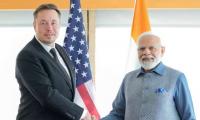The terrorist attack in New Zealand, which killed 50 people, has highlighted the changing landscape of terrorism in Europe, Australia and the US. This attack once again challenges the dominant understanding of extremism and terrorism in which Islam and Muslims are mostly associated with extremism – ignoring and denying the possibility of other forms of extremism.
For example, New Zealand’s Security Intelligence Service did not predict, or even mention, far-right extremism in its annual report. What is more perplexing, in the post-attack development, are the responses of Western leaders including the New Zealand prime minister and their inability to acknowledge the real issue at play, the notion of white racial supremacy.
The far-right threat wasn’t taken seriously even though reports have continuously suggested that in the last decade, there has been a rise of anti-immigrant populism. For instance, New Zealand First – a right-wing populist party and an ally of the current Labour government – has been propagating against the (increasing) presence of Asians in New Zealand. Its leader and current deputy prime minister, Winston Peters, has a history of xenophobia; he once warned that Asians would outnumber natives by 2021, which was factually incorrect. Although Peters himself is Maori-Scottish, his anti-immigrant politics have helped advance the propaganda put forward by white supremacists that ‘non-whites are polluting our lands’.
When Brenton Tarrant, the 28-year-old white supremacist, attacked worshippers in Christchurch, I ignorantly assumed that the debate on white supremacy would finally emerge on mainstream media and policymakers would investigate how the historical assertion of racial supremacy, credited to European colonial legacy, is enabling violence against non-whites. On the contrary, the response seems to have converted into another display of the ‘white man’s burden’ to pacify and justify the presence of Islam and Muslims in a white society. In fact, a few people have even raised the point that the prime minister’s face got more coverage than the victims.
It is a good gesture to show solidarity with Muslims and give symbolic statements such as the adhan (prayer) in parliament and make a human-chain outside a mosque. Undoubtedly, it is a relief to see such solidarity from the general public. It also gives a signal to far-right militants that the state stands with Muslims. But does this empathy really address far-right extremism? I agree it challenges one of the far-right’s positions – ie anti-Muslim – but does the far-right only hate Muslims?
In general, Muslims/Arabs, Jews and communists are the three most popular ‘enemies’ in almost all far-right or, more broadly, alt-right rhetoric. It might vary from case to case and it is possible that a far-right group only targets a specific religious, ethnic or sexual minority at a particular moment. For example, Dylann Roof, a 21-year-old white supremacist, who killed nine African-American churchgoers in 2015 in South Carolina, stated in his manifesto that although many Jews look white, there is a need to destroy their Jewish identity. Although Roof’s main target was African-Americans, it does not mean he was friendly to Jews or South Americans. So pacifying one religion might partially deal with the situation but the issue is much bigger. That raises a pertinent question: what should be the way to counter a force which has multiple enemies?
Countering extremism is relatively new and most of the strategies dealing with extremism and terrorism had emerged after 9/11. Therefore, all the models, tools and objectives were intrinsically Islam driven. For instance, one of the earliest and comprehensive strategies was the UK’s CONTEST introduced in 2006. It was introduced after the 2005 London bombings, in which three out of the four bombers were British-born Pakistanis. Counter-extremism strategies specifically in the West have viewed Islamic extremism as an issue of ‘non-integration’. Consequently, most of the staff that implement these strategies are trained to instil ‘Western values’ so that Muslims can integrate and overcome their ‘backwardness’.
This brings me to my main concern. Among all Western countries, the UK has the highest number of far-right cases. Recent stats suggest that the threat of the far-right extremely is unsurprisingly leaving behind Islamic extremism. In 13 years, white people have made up the largest proportion of arrest on terrorism suspicions in the UK. In 2017/2018, 394 people received support from the UK government counter extremism programme, Channel. 44 percent of the cases were related to right-wing extremism. Other figures add that around 600 school students aged between 10 to 20 were referred to PREVENT, part of CONTEST, on the far-right extremism in 2016/2017.
Now those strategies that were designed to counter Islamic extremism – such as PREVENT – are being used to counter the far-right. The issue here is that these far-right members are as integrated as any ordinary white person and as modern as Donald Trump. And it’s not even like a few adults are affected by this cancer. The PREVENT school referral shows that white/European supremacy is deeply rooted at the grassroots level, particularly in the middle class. Therefore, it requires a comprehensive response.
One such measure is to deconstruct the bogus idea of racial supremacy, specifically in schools and in the media. This would require a critical reading of European colonial crimes against Asians, Africans, Latin Americans, and the indigenous people of Australian and North American continents. It demands a realisation and confession that the idea of racial supremacy was constructed to justify the occupation of lands and genocidal violence against native people. There has been an effort to decolonise the curriculum at the university level, but schools in Europe are still unable to teach critical and objective history to students, showing how non-European races and cultures were demonised to elevate one race.
Similarly, one can’t counter the far-right without resolving or addressing the immigration issue. There is a strong conspiracy theory called ‘The Great Replacement’ which states that whites and Europeans are being replaced by immigrants. The whole anti-immigration narrative stands on this fear. As a result, far-right groups, such as Génération identitaire in France, use the term ‘remigration’ which demands that all non-Europeans must return to their countries of origin. Most far-right groups admire Trump because he shares and puts forwards the far-right’s core ideology – remigration.
Xenophobia and anti-immigrant sentiments have roots in racial supremacy. In the absence of critical reflection on colonial history and Western role in contemporary wars and turmoil, immigration is seen in isolation by the middle class. Immigration must be contextualised and sensitised. White people must know that immigration was not anyone’s first choice; it was a Global South dilemma where residual colonialism and Western intervention made lives miserable and unbearable. The Great Replacement must be challenged and informed with reparation. If the protection of Israel is European guilt, then justifying immigration must be an even bigger priority as the scale of violence in ‘former’ colonies was even more inhumane.
Lastly, Prime Minister Jacinda Ardern’s decision to keep the attacker nameless is bad policy. His name must be pronounced. His identity and skin colour must be revealed so that history remembers that violence had different shapes and names in the 21st century.
The writer is an activist and researcher.
Email: jafferamirza@gmail.com
Twitter: @jafferamirza
India uses Afghanistan as a backstage area to carry out terrorist attacks against Pakistan
Another report by the Pakistan Institute of Peace Studies states that 78 per cent of attacks have been carried out by...
Pakistan stands at the forefront of this crisis, generating a staggering 3.3 million tonnes of plastic waste annually
Today, a total of 11,000 children are attending Daanish schools in Punjab
The emotional instability of parents inculcates a range of psychological issues in children
The current way of dealing with the environment and climate change is no longer adequate







